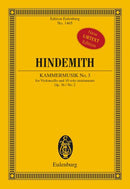| 作曲者 | Paul Hindemith (1895-1963)・パウル・ヒンデミット |
| タイトル | Kammermusik Nr. 3 op. 36/2 |
| サブタイトル | für obligates Violoncello und 10 Solo-Instrumente |
| 出版社 | Eulenburg・オイレンブルク |
| シリーズ名 | Eulenburg Taschenpartitur |
| 楽器編成 | solo-cello, flute (Piccolo), oboe, clarinet (Bb and Eb), bassoon, horn (F), trumpet (C), trombone, violin, cello and double bass |
| 楽器編成(詳細) | 1 (gr. auch kl.) · 1 · 1 (auch Es-Klar.) · 1 – 1 · 1 · 1 · 0 – Str. (1 · 0 · 0 · 1 · 1) |
| 品番 | 9790200225808 |
| 編曲者 | Giselher Schubert |
| 形状 | 76 ページ・120 g・ソフトカバー |
| 演奏時間 | 17分 |
| 作曲年 | 1925年 |
| 出版年 | 2011年 |
| 出版番号 | ETP 1465 |
| ISMN | 9790200225808 |
| ISBN | 9783795772154 |
The seven chamber music pieces are among Hindemith's most successful instrumental works of the 1920s and, in addition, of the new music of that time per se. At the world premiere of Chamber Music No. 1, the audience even demanded a repetition of the third and fourth movements. But the title is misleading: The individual pieces actually have concertante soloistic features instead of submitting to chamber music traditions. And so Chamber Music No. 3 is written for violoncello obbligato and 10 solo instruments.The score is based on Vol. VI/1 (PHA 401) of the Hindemith Complete Edition, edited by Giselher Schubert.
1. Majestätisch und stark - 2. Lebhaft und lustig - 3. Sehr ruhig und gemessen schreitende Viertel - 4. Mäßig bewegte Halbe. Munter aber immer gemächlich



